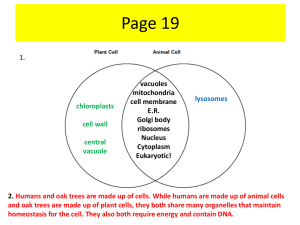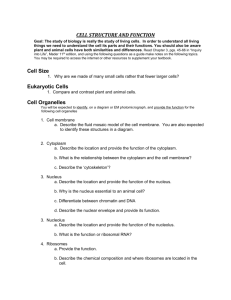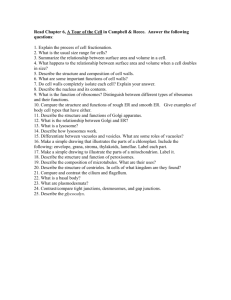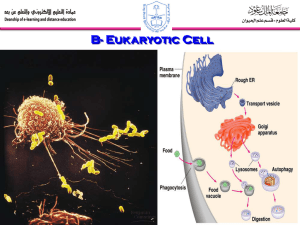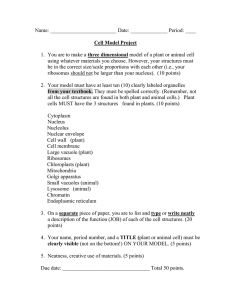محاضرة خامسة
advertisement
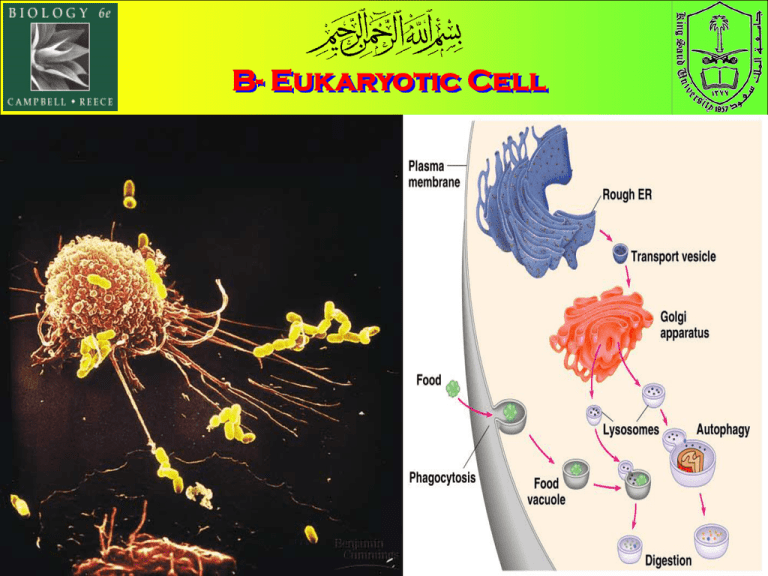
B- Eukaryotic Cell 3- The Endomembrane System a) The endoplasmic reticulum الشبكة اإلندوبالزميةmanufacturers membranes and performs many other biosynthetic functions b) The Golgi apparatus جهاز جولـﭽـىfinishes, sorts, and ships cell products c) The Lysosomes اليسوزوماتare digestive compartments d) The Vacuoles الفجواتhave diverse functions in cell maintenance A)- The endoplasmic reticulum (ER) manufacturers membranes and performs many other biosynthetic functions • The ER includes membranous tubules • There are two types of ER that differ in structure and function. 1. Smooth ER looks smooth ناعمةbecause it lacks ribosomes. 2. Rough ER looks rough خشنةbecause ribosomes (bound ribosomes) are attached to its outside. Fig. 7.11, Page 119 • The smooth ER: الشبكة اإلندوبالزمية الناعمة - It is rich in enzymes and plays a role in metabolic processes. - Its enzymes synthesize lipids ( دهونoils, phospholipids, and steroids) including the sex hormones الهرمونات الجنسية. - Extensive توجد بكثرةin the liver, it helps detoxify إبطال األثر السام drugs المخدراتand poisons السموم • The rough ER: الشبكة اإلندوبالزمية الخشنة - is especially abundant متوفرةin those cells that secrete proteins as it contains ribosomes. - These secretory proteins are packaged in transport vesicles that carry them to their next stage. B)- Golgi apparatus: finishes, sorts تـ ُ َجهز, packaging and ships تغلف وتنقلcell products • Many transport vesicles أوعية ناقلةfrom the ER travel to the Golgi apparatus for modification تطويرof their contents. • The Golgi function is manufacturing تصنيع, warehousing تغليف, sorting ( تـ َ ْجهيزPackaging), and shipping نقلmaterials to outside the cell. • The Golgi apparatus is especially extensive in cells specialized for secretion خاليا إفرازية. • The Golgi also manufactures pectin and polysaccharides. وعاء ناقل Fig. 7.12, Page 120 C)- Lysosomes األجسام ال ُمحللةare digestive components • The lysosome is a membrane-bounded sac كيسof enzymes that digests macromolecules. Fig. 7.13a, Page 121 Lysozomal enzymes Lysosomal enzymes work best at pH = 5 (acidic). The lysosomal enzymes are synthesized by rough ER and then transferred to تنقل إلىthe Golgi then to lysosomes. Function of Lysozomal enzymes 1) They hydrolyse يحللproteins, fats, polysaccharides, and nucleic acids. 2) Can destroy the cell by autodigestion (autophagy) الهضم الذاتى. 3) Can fuse with food vacuoles الفحجوة الغذائيةto digest food, (when a food item is brought into the cell by phagocytosis). 4) Can also fuse with another organelle or part of the cytosol. This process of autophagy called recycling which renews the cell Fig. 7.14, Page 122 D)- Vacuoles: الفجوات have diverse functions وظائف متنوعةin cell maintenance للحفاظ على الخلية • Vesicles أوعـيةand vacuoles فجواتare membrane-bound sacs أكياس ذات أغشيةwith varied functions. 1. Food vacuoles فجوة غذائية, from phagocytosis, fuse with lysosomes. 2. Contractile vacuoles فجوة منقبضة, found in freshwater protists, pump excess water out of the cell. 3. Central vacuoles فجوة مركزيةare found in many mature plant cells. خلية نباتية الفجوة المركذية خلية حيوانية Figs. 7.15 & 166, Page 123 Other Membranous Organelles A)- Peroxisomes contain enzymes that transfer hydrogen from various substrates to oxygen Functions of peroxisomes 1- Hydrogen peroxide (H2O2) is a poison, but the peroxisome has enzyme that converts H2O2 to water. 2- Some peroxisomes break fatty acids down to smaller molecules that are transported to mitochondria for fuel إلنتاج الطاقة. 3- They detoxify سمى ُّ يبطل المفعول الalcohol and other harmful compounds. Thus, it exists extensively in the liver cells Other Membranous Organelles B)- Mitochondria: Thy are the main energy transformers of cells as they convert energy to fuel الطاقةthat cells can use for work. • Mitochondria are the sites of cellular respiration, • generating تـُن ِتجATP from the catabolism هدمof sugars, fats, and other fuels مصادر طاقةin the presence of oxygen. • Almost all eukaryotic cells have mitochondria. • Mitochondria and chloroplasts are mobile and move around the cell along tracks in the cytoskeleton. • Mitochondria have a smooth outer membrane and a highly folded inner membrane forming cristae نتوءات. • The inner membrane encloses the mitochondrial matrix, a fluid-filled space with DNA, ribosomes, and enzymes. Fig. 7.17, Page 124

